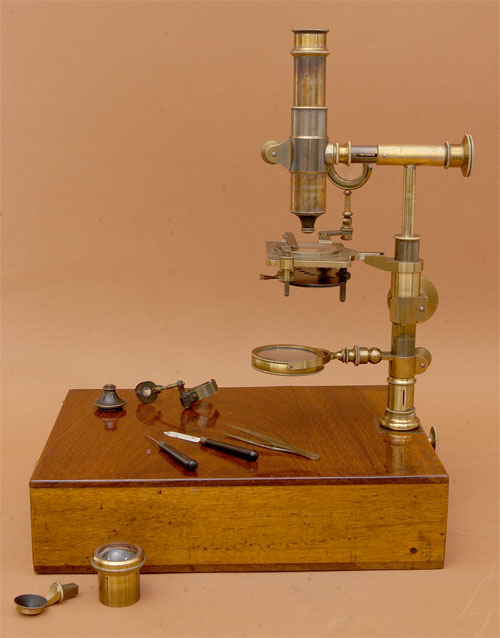This is a combination microscope designed by Francois-Vincent Raspail and made by Louis Joseph Deleuil (1795–1862) c1840. The instrument consists of two separate microscopes: a simple magnifier or "aquatic" microscope, and a compound, higher magnification instrument. These two microscopes can be interchanged by replacing the lens system holder. The illuminating mirror, main support pillar, and focusing mechanism remains constant between the two configurations. The support pillar inserts into a brass fitting at one end of the mahogany base. Its end is round, which allows the microscope to be rotated to face away from the base, or tilted to a horizontal position. Sample focus is by rack & pinion movement of the stage. The microscope body is supported at the end of a translating cantilever by a solid brass shaft pressed into a cork-lined insert at the top of the support pillar. Coarse focus is accomplished by pushing the shaft up or down. Axial alignment of the microscope relative to the sample stage is accomplished by turning a thumbscrew at the end of the cantilever. This rotates a threaded rod that extends or retracts the microscope body. The stage is a solid brass rectangle with a central circular cutout. Either a glass or blackened brass disc fits into the hole. Attached to the stage are three screw clamps. One for the bull's eye lens mount and the other two for the sample clips. Beneath the stage is an aperture consisting of two opposing discs. One has a series of offset holes and the other has a rectangular slot. Sliding one against the other reveals circular apertures of the same diameter but that illuminate different positions along the stage. The mirror is attached to the support pillar via a screw clamp collar. It has a round hinge that allows the mirror to be rotated away from the optic axis. The optics are of two styles. The aquatic microscope is a simple magnification system consisting of six different lenses. The compound microscope has two objectives, a field lens (now missing), and a Huygenian eyepiece. The missing field lens only causes vignetting of the field of view. Imaging is typical early 19th Century containing some optical aberrations (chromatic and spherical).
There are few accessories. One of the most interesting is a hemispherical glass collar for fitting over the objective end of the microscope body. When attached the glass acts as a "dipping lens" allowing the user to image samples in water. This instrument also includes an eyepiece camera lucida attachment for making hand drawings of samples, plus three dissection instruments. The microscope can be disassembled and stored in the drawer within the wooden base. The total height of the microscope is approximately 38cm tall.
Francois-Vincent Raspail (1794–1878) was a political and scientific figure in France in the early 19th Century. One of his accomplishments was the invention of a type of aquatic microscope exemplified by Golub microscope No. 235. This instrument is a small, simple magnifier set on a wooden base. The design was so similar to the original aquatic microscope design by John Cuff that Vincent and Charles Chevalier filed a complaint to the Académie Royal des Sciences stating that the Raspail aquatic microscope plagairized Cuff. This resulted in the introduction a few years later of a much larger and robust instrument by Raspail that doubled as an aquatic or compound microscope. These two designs are exemplified here.
Although Raspail designed these two microscopes they were made at the firm started by Louis Joseph Deleuil (1795–1862) and subsequently managed by his son Jean Adrien (1825–1894). Their firm made a great many scientific and philosophical instruments including the two Deleuil microscopes in the Golub Collection.
Featured 07/2023






